|
|
|
Sort Order |
|
|
|
Items / Page
|
|
|
|
|
|
|
| Srl | Item |
| 1 |
ID:
120655
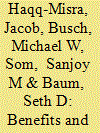

|
|
|
|
|
| Publication |
2013.
|
| Summary/Abstract |
Deliberate and unintentional radio transmissions from Earth propagate into space. These transmissions could be detected by extraterrestrial watchers over interstellar distances. This article analyzes the harm and benefits of deliberate and unintentional transmissions relevant to Earth and humanity. Comparing the magnitude of deliberate radio broadcasts intended for messaging to extraterrestrial intelligence (METI) with the background radio spectrum of Earth, we find that METI attempts to date have much lower detectability than emissions from current radio communication technologies on Earth. METI broadcasts are usually transient and several orders of magnitude less powerful than other terrestrial sources, such as astronomical and military radars, which provide the strongest detectable signals. The benefits of radio communication on Earth most probably outweigh the potential harm of detection by extraterrestrial watchers; however, the uncertainty regarding the outcome of contact with extraterrestrial beings creates difficulty in assessing whether or not to engage in long-term and large-scale METI.
|
|
|
|
|
|
|
|
|
|
|
|
|
|
|
|
| 2 |
ID:
120651
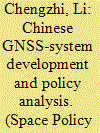

|
|
|
|
|
| Publication |
2013.
|
| Summary/Abstract |
As the most successful dual-use technology at present the Global Navigation Satellite System (GNSS) also has extensive recognition in China. China began developing navigation satellites in 1967 and now has 45 years' experience in the field. 2012 was a crucial year for China's GNSS: the first-stage project of the second-generation global navigation satellite system was rounded off, and it entered service for regional area navigation and positioning. This paper discusses the development history of China's satellite navigation, analyzes the background to China's decision to develop an independent GNSS and investigates the formation of its three-step development strategy. It reviews the system construction and industrial policy of the BeiDou system and the actions taken by various government departments at different times.
|
|
|
|
|
|
|
|
|
|
|
|
|
|
|
|
| 3 |
ID:
120654
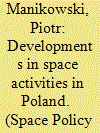

|
|
|
|
|
| Publication |
2013.
|
| Summary/Abstract |
Poland has a long-standing tradition in space activities. Polish institutions have participated as co-investigators in almost all European Space Agency (ESA) science projects, as well as on many other missions. However, the first Polish satellite (PW-SAT) was only launched in 2012. Poland was one of the first Eastern European countries to conclude a Cooperation Agreement with ESA in the peaceful use of outer space; it was signed in 1994 and followed by a second in January 2002. Negotiations on Polish membership in the ESA were started in autumn of 2011, and ended in April 2012. Following ratification of the agreement, Poland officially became the 20th Member State of ESA on 19 November 2012. This article examines how Poland is setting its way as a space nation. It describes recent developments in the Polish space programme, including the road to Poland's full membership in the European Space Agency.
|
|
|
|
|
|
|
|
|
|
|
|
|
|
|
|
| 4 |
ID:
120653


|
|
|
|
|
| Publication |
2013.
|
| Summary/Abstract |
In June 2012, four whole years after the Basic Space Law mandated a fundamental reorientation of Japan's space policy objectives towards applications, including national security and the use of space as a diplomatic tool, legislation was passed by Japan's Diet that alters who controls Japan's space policy. The new legislation involves a curious compromise between competing aims and objectives of different parts of Japan's central bureaucracy. But it also clearly represents a break from the past and potentially a decisive step toward new directions for Japan's governmental space efforts. Contextualizing the deeper and immediate background, this article seeks to elucidate just how deep, or indeed shallow, some of the forthcoming changes are.
|
|
|
|
|
|
|
|
|
|
|
|
|
|
|
|
| 5 |
ID:
120657
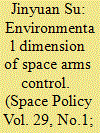

|
|
|
|
|
| Publication |
2013.
|
| Summary/Abstract |
Current debates on the prevention of an arms race in outer space are dominated by the traditional perspective of international strategic balance. This article addresses the issue through the often-neglected lens of environmental protection, reviewing a number of environmental instruments as they relate to outer space. It argues that environmental protection, as a non-traditional element, is an instrumental impetus for arms control. The current regime leaves the door open for states to develop conventional orbital weapons and ground-based anti-satellite weapons (ASATs), which would have a significant adverse impact on the space environment. Thus the law of environmental protection is deficient in effectively protecting the space environment from pollution resulting from military activities. It is further argued that the space arms control regime should be strengthened for humanity's common interest in a sustainable space environment. Preferably an international treaty should be concluded to prohibit testing, deployment and use of space-based weapons and ASATs. These substantive obligations also conform to the requirements of safeguarding international peace and security, and the security interests of spacefaring countries.
|
|
|
|
|
|
|
|
|
|
|
|
|
|
|
|
| 6 |
ID:
120658
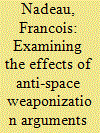

|
|
|
|
|
| Publication |
2013.
|
| Summary/Abstract |
This study examines how political activists are framing the space weaponization debate in Canada and whether their arguments can influence public attitudes and perceptions about the issue. Eighty university students from two undergraduate courses were recruited as participants in a quasi-experiment. One class (n = 38) was exposed to the documentary Masters of Space, an episode of the Canadian Broadcasting Corporation's program The Nature of Things, and another class (n = 42) served as the control group. Pre-test and post-test questionnaires were used to measure the effects of viewing anti-weaponization arguments in the media, while also controlling for the influence of prior beliefs and background characteristics of participants. Results suggest that visually depicting the use of satellite technology in society can convince viewers that satellites are important to their way of life, but not necessarily to the defense of North America. Framing missile defense as a 'space weapon in disguise' also seemed to raise opposition to Canada's participation in continental missile defense. The findings, meanwhile, indicate that viewers respond strongly to the issue of space debris and that mobilizing support for joint military space projects may best be achieved by emphasizing the usefulness of these projects for locating and tracking such debris. In the end, media exposure seemed to help legitimize anti-weaponization arguments based more on rational self-interests than on idealistic beliefs. These findings can have implications for the way space policies are communicated to the public.
|
|
|
|
|
|
|
|
|
|
|
|
|
|
|
|
| 7 |
ID:
120652
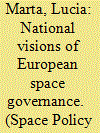

|
|
|
|
|
| Publication |
2013.
|
| Summary/Abstract |
The governance of space activities in Europe remains an open question, even more so since the adoption of the Lisbon Treaty, and the latest EC document and ESA declaration have revived the debate. This paper considers the strengths and weaknesses of the current governance model, and compares recent French, German, Italian and UK national documents in order to highlight their vision of space governance in Europe. Some elements of agreement emerge but, more interestingly, this comparison highlights their differences, especially with regard to the role of the EU as a supranational actor in the space domain.
|
|
|
|
|
|
|
|
|
|
|
|
|
|
|
|
| 8 |
ID:
120659


|
|
|
|
|
| Publication |
2013.
|
| Summary/Abstract |
Satellite remote sensing technology has contributed to the transformation of multiple earth science domains, putting space observations at the forefront of innovation in earth science. With new satellite missions being launched every year, new types of earth science data are being incorporated into science models and decision-making systems in a broad array of organizations. Policy guidance can influence the degree to which user needs influence mission design and when, and ensure that satellite missions serve both the scientific and user communities without becoming unfocused and overly expensive. By considering the needs of the user community early on in the mission-design process, agencies can ensure that satellites meet the needs of multiple constituencies. This paper describes the mission development process in NASA and ESA and compares and contrasts the successes and challenges faced by these agencies as they try to balance science and applications within their missions.
|
|
|
|
|
|
|
|
|
|
|
|
|
|
|
|
| 9 |
ID:
120656


|
|
|
|
|
| Publication |
2013.
|
| Summary/Abstract |
Government organizations have to justify high expenditure during periods of financial crisis such as the one we are experiencing today. Space agencies have attempted to increase the returns on their investments in space missions by encouraging the commercial use of advanced technologies. This paper describes two technology transfer (TT) cases promoted by JAXA, in order to identify the organizational models and determinants of TT. The development of a TT process from space to Earth not only benefits the aerospace industry but also the network of national companies. The aim of the paper is to investigate who the actors are and the nature of their role, as well as the determinants of the TT process in the Japanese space sector. The case studies confirm the typical path of transfer as 'Earth-space-Earth'.
|
|
|
|
|
|
|
|
|
|
|
|
|
|
|
|
| 10 |
ID:
120650


|
|
|
|
|
| Publication |
2013.
|
| Summary/Abstract |
Many UN agencies use space data as a tool to promote global sustainable development, yet the use of space has barely been acknowledged, let alone understood, by decision makers at the various UN and international meetings on the environment and development. Following discussions held at a side-event to the 2012 Rio+20 conference, the author highlights the various ways space applications can be used to meet the challenges (in resource use, disaster management, environmental protection and climate change) of sustainable development and urges policy makers to inform themselves of the benefits of space applications.
|
|
|
|
|
|
|
|
|
|
|
|
|
|
|
|
|
|
|
|
|